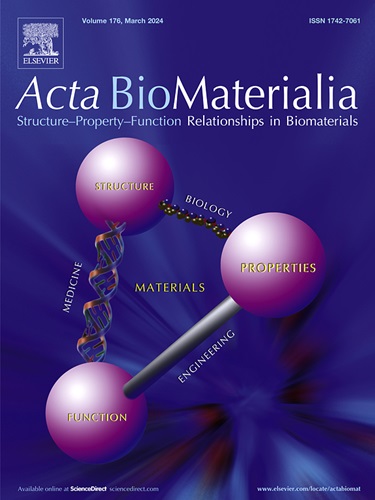Reversible light-responsive protein hydrogel for on-demand cell encapsulation and release
IF 9.4
1区 医学
Q1 ENGINEERING, BIOMEDICAL
引用次数: 0
Abstract
The design of biomaterials that can reconfigure on-demand in response to external stimuli is an emerging area in materials research. However, achieving reversible assembly of protein-based biomaterials by light input remains a major challenge. Here, we present the engineering of a new protein material that is capable of switching between liquid and solid state reversibly, controlled by lights of different wavelengths. The materials are created by incorporating a light-responsive mutant Dronpa protein domain into the backbone of Elastin-Like Proteins (termed DELPs). We show that the DELP material can respond to light and undergo multiple cycles of switching between hydrogel and solution, outperforming the conventional irreversible materials. Additionally, the material is biocompatible with long-term cell proliferation in both adherent and suspension cells. Building on the reversible assembly of the material, we demonstrate efficient cell encapsulation and release upon light triggers. The design principle of incorporating a light-responsive protein element into a structural protein matrix, as demonstrated in this work enables, a broad range of other applications that require adaptive materials to intelligently interface with dynamic biological systems and environments.
Statement of significance
This work generates a new class of “smart” biomaterials that uniquely switches between liquid and gel states in response to light input. Light input can be precisely delivered in space and time, highly tunable through wavelengths, intensities, and durations of light exposure. In prior research, light-responsive biomaterials are mostly irreversible, limiting their use to only uni-directional applications and the materials cannot be re-used. In contrast, this material robustly displays reversible switching between liquid and gel using a light-responsive crosslinker. Furthermore, the material is biocompatible, programmable, and suitable for broad applications including but not limited to cell encapsulation, controlled release, tissue engineering, and cell/tissue mechanobiology.

可逆光响应蛋白水凝胶按需细胞封装和释放。
设计可根据外部刺激按需重组的生物材料是材料研究的一个新兴领域。然而,通过光输入实现蛋白质生物材料的可逆组装仍然是一个重大挑战。在这里,我们展示了一种新型蛋白质材料的工程设计,这种材料能够在不同波长的光线控制下在液态和固态之间可逆切换。这种材料是通过在弹性蛋白(Elastin-Like Proteins,简称 DELPs)的骨架中加入光响应突变 Dronpa 蛋白结构域而产生的。我们的研究表明,DELP 材料能够对光做出反应,并在水凝胶和溶液之间进行多次循环切换,性能优于传统的不可逆材料。此外,这种材料还具有生物相容性,可在粘附细胞和悬浮细胞中长期增殖。在该材料可逆组装的基础上,我们展示了光触发时高效的细胞包裹和释放。将光响应蛋白元件融入结构蛋白基质的设计原理,正如这项研究工作所展示的那样,能够应用于其他需要自适应材料与动态生物系统和环境智能连接的广泛领域。意义说明:这项工作产生了一类新的 "智能 "生物材料,可根据光输入在液态和凝胶态之间进行独特的切换。光输入可以在空间和时间上精确传递,通过波长、强度和光照射持续时间进行高度可调。在之前的研究中,光响应生物材料大多是不可逆的,这就限制了它们只能用于单向应用,而且材料不能重复使用。与此相反,这种材料利用光响应交联剂在液体和凝胶之间实现了稳健的可逆切换。此外,这种材料还具有生物相容性和可编程性,适用于广泛的应用领域,包括但不限于细胞封装、控制释放、组织工程和细胞/组织机械生物学。
本文章由计算机程序翻译,如有差异,请以英文原文为准。
求助全文
约1分钟内获得全文
求助全文
来源期刊

Acta Biomaterialia
工程技术-材料科学:生物材料
CiteScore
16.80
自引率
3.10%
发文量
776
审稿时长
30 days
期刊介绍:
Acta Biomaterialia is a monthly peer-reviewed scientific journal published by Elsevier. The journal was established in January 2005. The editor-in-chief is W.R. Wagner (University of Pittsburgh). The journal covers research in biomaterials science, including the interrelationship of biomaterial structure and function from macroscale to nanoscale. Topical coverage includes biomedical and biocompatible materials.
 求助内容:
求助内容: 应助结果提醒方式:
应助结果提醒方式:


